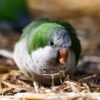- How Long Does A Quaker Parrot Live? - 17 May 2024
- 4 Hacks on Keeping Your Home Clean With Pets - 28 March 2024
- 5 Things to Know Before Bringing Home a New Kitten - 26 March 2024
Big Eyeball Goldfish are the most popular, with different gold, orange, and white varieties. With their bright colors, Goldfish with big eyes are adorable, making them a great addition to the home aquarium. They come in different sizes and shapes, including fancy verities. Here, you will get to know about the surprising facts that you should know about Big Eyeball Goldfish.
What are the Goldfish with Big Eyes Called?
Goldfish with protruding eyes are a particular type of fish that have evolved into dragon eyes. It makes them unique and adorable, but they require special care and attention compared to regular Goldfish. The most common variety of this species is called the Telescope Goldfish. The eyes can be black, red, or other colors, and their spherical shape enlarges the field of vision for the fish.

Appearance of Big Eyeball Goldfish
| Feature | Description |
| Eyes | Large, round, and protruding eyes that may point slightly upward |
| Body Shape | Short, stocky, and egg-shaped body |
| Fins | Long, flowing fins with a double caudal fin (divided tail fin) |
| Coloration | Wide range of colors including metallic(red, orange, yellow, white, black) |
| Scales | Shimmering metallic scales or matte scales. |
Are Big Eyeball Goldfish Natural?
These Goldfish are a type of Goldfish that can naturally occur in the wild. These types of goldfish feature protruding eyes. They are sometimes called Goldies. The Goldfish is also known as a colored fish with big eyes.
What Do Goldfish with Big Eyes Eat?
They have the same dietary needs as other goldfish varieties. Their diet should have a balanced and nutritious feeding regimen to support their health and well-being. Here are some considerations regarding the diet of Goldfish with big eyes:
- High-Quality Commercial Fish Food
They can be fed a high-quality pellet or flake food formulated for Goldfish. Find options that balance protein, fats, carbohydrates, and essential vitamins and minerals. Choosing sinking pellets or flakes is recommended to ensure these fish can reach the food easily.
- Variety of food
Along with commercial fish food, it’s beneficial to offer a variety of foods to provide a more diverse diet. This can include freeze-dried or frozen foods such as bloodworms, brine shrimp, daphnia, or chopped veggies like peas. These foods can add nutritional variety and stimulate natural feeding behaviors.
- Occasional treats
Goldfish can enjoy occasional treats like small pieces of fruit, but these should be given sparingly and in small portions. Treats shouldn’t replace the main diet but can be offered as occasional supplements. Younger Goldfish may require food with high protein content to support growth, while older Goldfish can benefit from a diet with reduced protein levels. Adjusting the diet as your Goldfish grows can meet its changing nutritional needs.
- Dietary needs
Younger Goldfish may require food with higher protein content to support growth, while older Goldfish can benefit from a diet with reduced protein levels. Adjusting the diet as your Goldfish grows can help meet its changing nutritional needs.
How Do You Care For A Goldfish?
Caring for a goldfish involves providing a suitable environment, proper nutrition, regular maintenance, and monitoring their health. Here are essential care guidelines for Goldfish:
- Take or Pond Setup
Goldfish require a spacious or well-maintained tank or pond. For a tank, provide at least 20 gallons of water per Goldfish. A larger tank with a good filtration system is preferable.
- Water Quality
Maintain good water quality by regularly testing the water parameters such as ammonia, nitrite, pH, and temperature. Perform regular water changes to remove toxins and maintain optimal conditions. Goldfish are sensitive to poor water quality, so a reliable filtration system is essential.
- Temperature and Environment
Goldfish are Coldwater fish and thrive in temperatures between 65-75°F. Avoid exposure to extreme temperature fluctuation or keep in warm environments. Provide hiding spots, plants, and ornaments in the tank to create a stimulating environment.
- Monitor and Healthcare
Regularly observe your Goldfish for any signs of illness, abnormal Behavior, or physical changes. Look for symptoms like loss of appetite and abnormal swimming patterns. If you notice any issues, consult a veterinarian experienced in fish health for proper diagnosis and treatment.
Can Goldfish Get Popeye?
Yes, Goldfish can develop a condition known as Popeye. They refer to the swelling or protrusion of one or both eyes. It is characterized by the eyes appearing swollen, cloudy, or bulging out from the sockets. This is not a disease but rather a symptom of underlying issues. The most common causes of Popeye in Goldfish include bacterial infections, poor water quality, and physical injury or health problems.
They are a common cause of Popeye in Goldfish. The bacteria can enter the fish’s system through wounds, injuries, or compromised immune function. Take action promptly when you see the complications. Improve water quality and appropriately treat bacterial infections to address health issues.

How Long Do Big Eyeball Goldfish Live For?
Telescope Goldfish have the potential to live for many years with proper care. They can live for 6 to 25 years or longer in optimal conditions. Goldfish require plenty of dissolved oxygen in their tanks, so filtration is recommended for larger tanks.
What are Telescope Goldfish Eye Problems?
They suffer from various eye problems due to their protruding eyes. The main issues seen in telescope goldfish include cataracts, ulcers, and cloudiness or discoloration of the eyeballs. These conditions can be managed with medication or other treatment but often require surgical intervention. Prevention measures may include:
- Regular partial water changes
- Appropriate filtration systems
- Ensuring good diet and tank mates for the best health of fish

Conclusion
These are the exciting facts about eyeball Goldfish. They are visually appealing and require proper pet care and attention to ensure well-being. Providing a spacious tank or pond, maintaining good water quality, and offering a balanced diet are essential for their health. Following these guidelines and providing a nurturing environment, you can enjoy the companionship of these unique fish.
















